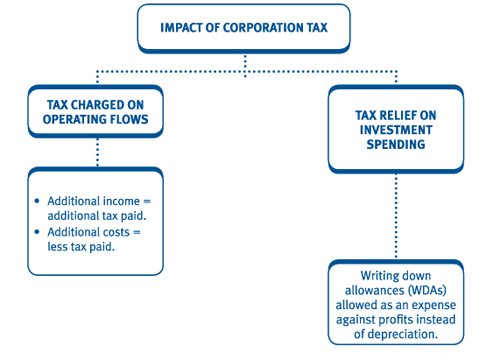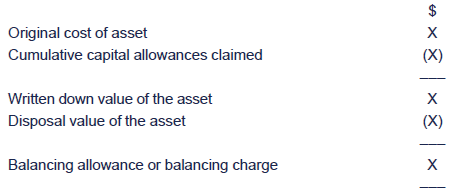NPV with taxation
When appraising capital projects, basic techniques such as ROCE and Payback could be used. Alternatively, companies could use discounted cash flow techniques such as Net Present Value (NPV) and Internal Rate of Return (IRR). This page looks at how to take account of taxation when using NPV techniques.
Taxation
Since most companies pay tax, the impact of corporation tax must be considered in any investment appraisal.
Corporation tax charged on a company's profits is a relevant cash flow for NPV purposes.
Impact of taxation on the discount rate used
When calculating the WACC, the cost of debt should always be a "post tax" figure - i.e. has been adjusted for the tax relief on interest. This is the normal way of determining the WACC so no extra work is required.
Impact of taxation on cash flows
Taxation has the following effects on an investment appraisal problem:
Project cash flows will give rise to taxation which itself has an impact on project appraisal.
Organisations benefit from being able to claim capital allowances (WDAs) - a tax deductible alternative to depreciation. The effect of these is to reduce the amount of tax that organisations are required to pay.
In practice, the effects of taxation are complex, and are influenced by a number of factors including the following:
the taxable profits and tax rate
the company's accounting period and tax payment dates
capital allowances
losses available for set-off
but many of these issues are ignored or simplified for the purposes of NPV investment appraisal.
Capital allowances/WDAs
For tax purposes, a business may not deduct the cost of an asset from its profits as depreciation (in the way it does for financial accounting purposes).
Instead the cost must be deducted from taxable profits in the form of 'capital allowances' or WDAs. The basic rules are as follows:
- WDAs are calculated based on the written down value of the assets (this will either be on a reducing balance or straight line basis - read the question carefully)
- the total WDAs given over the life of an asset equate to its fall in value over the period (i.e. the cost less any scrap proceeds)
- WDAs are claimed as early as possible
- WDAs are given for every year of ownership except the year of disposal
- in the year of sale or scrap a balancing allowance (BA) or balancing charge arises (BC).

Note: As financial management terms continue their internationalisation, the term 'capital allowance' or 'writing down allowance' is sometimes being replaced by 'tax allowable depreciation'. All three terms can be used interchangeably
The timing of the asset purchase.
Assets are assumed to be bought at T0.
This could be the very end of an accounting period (e.g. 31/12/X1) or the start of another (e.g.1/1/X2).
There is no distinction between these dates for discounting, but there is for tax.
Asset bought at the start of an accounting period:

Asset bought at the end of an accounting period:
Laying out long NPV questions
For the majority of investment appraisal questions in exams, the following pro-forma is recommended:
|
Created at 9/14/2012 10:01 AM by System Account
(GMT) Greenwich Mean Time : Dublin, Edinburgh, Lisbon, London
|
Last modified at 11/13/2012 12:01 PM by System Account
(GMT) Greenwich Mean Time : Dublin, Edinburgh, Lisbon, London
|
|
|
|
 |
Rating
:
|
 Ratings & Comments
(Click the stars to rate the page) Ratings & Comments
(Click the stars to rate the page)
|
 |
Tags:
|
|
|
|
|